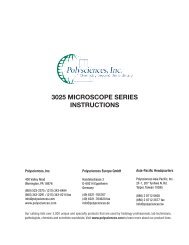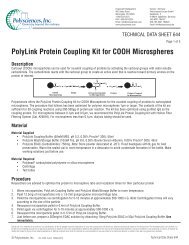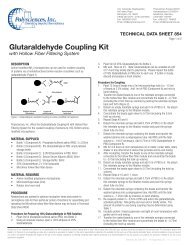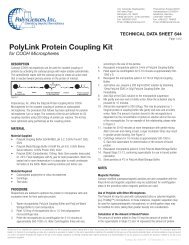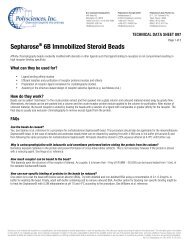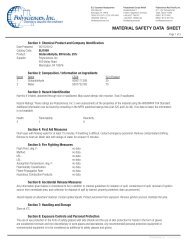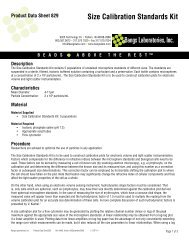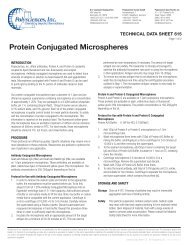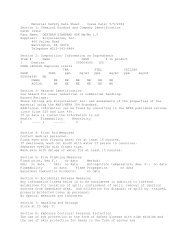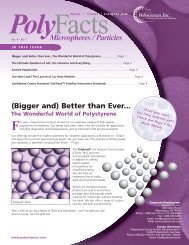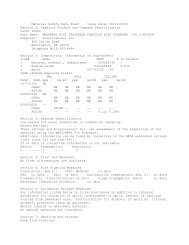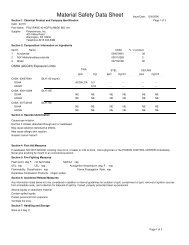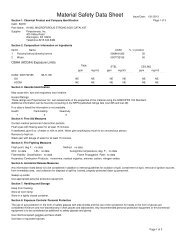JB-4 Embedding Kit® - Polysciences, Inc.
JB-4 Embedding Kit® - Polysciences, Inc.
JB-4 Embedding Kit® - Polysciences, Inc.
You also want an ePaper? Increase the reach of your titles
YUMPU automatically turns print PDFs into web optimized ePapers that Google loves.
Corporate Headquarters<br />
400 Valley Road<br />
Warrington, PA 18976<br />
1-800-523-2575<br />
FAX 1-800-343-3291<br />
Email: info@polysciences.com<br />
www.polysciences.com<br />
Europe - Germany<br />
<strong>Polysciences</strong> Europe GmbH<br />
Handelsstr. 3<br />
D-69214 Eppelheim, Germany<br />
(49) 6221-765767<br />
FAX (49) 6221-764620<br />
Email: info@polysciences.de<br />
<strong>JB</strong>-4 <strong>Embedding</strong> Kit ®<br />
Catalog #00226<br />
TECHNICAL DATA SHEET 123<br />
Page 1 of 3<br />
Introduction<br />
<strong>JB</strong>-4 <strong>Embedding</strong> Kit is a unique polymer embedding material that gives a higher level of morphological detail than paraffin processed<br />
tissues. A water-soluble media, <strong>JB</strong>-4 does not require dehydration to absolute alcohol except for dense, bloody, or fatty tissue specimens.<br />
<strong>JB</strong>-4 is excellent for small non-decalcified bone specimens, routine stains, special stains, and histochemical staining. Clearing agents<br />
such as xylene and chloroform are not required. The polymerization of <strong>JB</strong>-4 is exothermic, which is easily controlled by polymerizing<br />
on ice or by using refrigeration at 4°C. <strong>JB</strong>-4 <strong>Embedding</strong> Kits must be used under a chemical fume hood.<br />
Sections of <strong>JB</strong>-4 embedded material can be cut at 0.5 to 3.0 microns or thicker. Microtomes designed for plastic sectioning are required<br />
as are glass, Ralph, or tungsten carbide knives. Immunohistochemical procedures are not recommended for <strong>JB</strong>-4 as the glycol methacrylate<br />
cannot be removed from the section and may block antigen sites for most antibody reactions. As an alternative we recommend the<br />
<strong>Polysciences</strong>, <strong>Inc</strong>. Osteo-Bed Bone <strong>Embedding</strong> Kit (Catalog #17734). The Osteo-Bed formulation is a methyl methacrylate that is well<br />
suited for bone or soft tissue for immunohistochemistry.<br />
NOTE<br />
It is recommended that the <strong>Embedding</strong> Kit be used under a fume<br />
hood with appropriate gloves. For additional details, see Warnings<br />
and Precautions.<br />
Fixation<br />
Specimens can be fixed in 10% Neutral Buffered Formalin or other<br />
routine histological fixative. We suggest using Poly/LEM, a methanol<br />
free formalin based fixative for light and electron microscopy. Routine<br />
specimen sizes for soft tissue should be no more than 2.0cm X 2.0cm<br />
X 2.0cm with fixation at a minimum of four hours to overnight. Fatty or<br />
dense tissues should be fixed overnight. Larger bone specimens will<br />
require fixation overnight or longer depending on the specimen size.<br />
Fixation can be at room temperature or 4°C. Cold fixation will extend<br />
the time required for the specimen to be penetrated and fixed.<br />
Decalcification is not required for <strong>JB</strong>-4 embedded specimens.<br />
Dehydration<br />
Dehydration can be completed at room temperature or 4°C. This<br />
process can also be done with a routine tissue processor, stopped at the<br />
end of the last alcohol step and removed for infiltration. Please note that<br />
polymers cannot be used in routine histology tissue processors at any<br />
time. It may void the warranty and possibly begin to polymerize in the<br />
system thereby blocking the lines. Check with the manufacturer prior to<br />
attempting infiltration on any unit.<br />
Infiltration<br />
Infiltration Solution Mixing Procedure:<br />
The following amounts of material are used for one 100ml batch<br />
of Infiltration Solution:<br />
<strong>JB</strong>-4 Solution A (Monomer)<br />
Benzoyl Peroxide, Plasticized (Catalyst)<br />
100.00ml<br />
1.25gm<br />
Carefully weigh 1.25gm of catalyst (benzoyl peroxide, plasticized) and<br />
add to 100.00ml Solution A while stirring on a magnetic stirrer. Mix until<br />
dissolved, approximately 10 to 20 minutes. Measurement of the<br />
catalyst is critical because it controls the rate of polymerization of the<br />
plastic and the exothermic reaction. This infiltration solution can be<br />
stored for up to two weeks in a dark cool area or in the refrigerator<br />
at 4°C.<br />
Infiltration Procedure<br />
Infiltration is performed at room temperature or 4°C. Do not expose the<br />
samples to heat or direct light during infiltration. The specimens should<br />
be placed in two to three changes of Infiltration Solution to allow for the<br />
removal or replacement of all alcohols or tissue fluids.<br />
Dehydration and infiltration can be completed simultaneously by using<br />
absolute alcohol in ascending grades of infiltration solution starting at<br />
50% ethanol and 50% infiltration solution followed by 25% ethanol;<br />
75% infiltration solution then 10% ethanol to 90% infiltration solution<br />
and finally in infiltration solution for a minimum of 3 changes prior to<br />
embedding. Proceed to the embedding steps.<br />
Should any of our materials fail to perform to our specifications, we will be pleased to provide replacements or return the purchase price. We solicit your inquiries concerning all needs for life sciences work. The information given in this<br />
bulletin is to the best of our knowledge accurate, but no warranty is expressed or implied. It is the user’s responsibility to determine the suitability for his own use of the products described herein, and since conditions of use are beyond<br />
our control, we disclaim all liability with respect to the use of any material supplied by us. Nothing contained herein shall be construed as a recommendation to use any product or to practice any process in violation of any law or any<br />
government regulation<br />
©<br />
<strong>Polysciences</strong>, <strong>Inc</strong>. / Revised 21/April/2008 Data Sheet #123 1
TECHNICAL DATA SHEET 123<br />
Page 2 of 3<br />
The amount of infiltration solution used is approximately 8 to 10 times<br />
that of the volume of the specimen. The changes of fluid should occur<br />
every 10 to 90 minutes for smaller specimens. The time in each change<br />
is dependent on the size of the specimen. When infiltration is complete<br />
the tissue generally appears translucent and in most cases will sink to<br />
the bottom of the container. Infiltration should be done on a slow rotator,<br />
hematology shaker table or inverted several times during the<br />
process to allow complete saturation.<br />
<strong>Embedding</strong><br />
The polymerization process should be under anaerobic conditions<br />
with the use of block holders, under light vacuum or in an air-tight<br />
container.<br />
Prior to mixing the <strong>Embedding</strong> Solution, collect and prepare the following<br />
materials; embedding molds, block holders, labels, gloves, instruments,<br />
an ice bath,and the specimens. Do not pre-cool the molds as this<br />
may cause condensation and prevent even polymerization of the block<br />
face. To prevent polymerization from occurring too fast and possible<br />
overheating of the tissue it is recommended that the polymerization<br />
process for embedding be slowed by completing it in the refrigerator or<br />
in a cold room at 4°C. Note that this may extend the polymerization from<br />
several hours to overnight.<br />
Larger specimens with increased embedding solution may have an even<br />
greater exothermic reaction. This should be controlled by using a 4°C<br />
refrigerator or cold room. These larger specimens will require longer<br />
times for complete polymerization and may have more unpolymerized<br />
liquid on top of the block. This will appear as a syrup and should be<br />
allowed to drain off the blocks by inverting the molds upside down and<br />
then wiping off excess. It is recommended that gloves be worn to<br />
reduce exposure to un-polymerized resin.<br />
<strong>Embedding</strong> Solution Mixing Procedure<br />
Make fresh Solution A following the directions in Infiltration<br />
Solution and Procedures above. Do not use old or used<br />
catalyzed Infiltration Solution for the embedding solutions.<br />
The following amounts of material are used for 25ml of embedding<br />
solution:<br />
Infiltration Solution<br />
<strong>JB</strong>-4 Solution B (Accelerator)<br />
25.0ml<br />
1.0ml (Must be an exact measurement.)<br />
Mix 25ml of freshly made Infiltration Solution and 1.0ml of <strong>JB</strong>-4<br />
Solution B thoroughly and begin embedding immediately. The small<br />
<strong>JB</strong>-4 <strong>Embedding</strong> Molds from <strong>Polysciences</strong>, <strong>Inc</strong>. require approximately<br />
1.5 to 2ml of solution per mold. The Block Holder is essential to exclude<br />
oxygen during the polymerization process. If Block Holders are not<br />
used, cover the molds with an air tight film or place under vacuum at no<br />
more than 15psi, preferably in a cold room at 4°C or a refrigerator.<br />
If anaerobic conditions are not maintained, the <strong>JB</strong>-4 may polymerize<br />
incompletely or not all. BEEM ® capsules may be capped for embedding.<br />
We recommend polymerization in the refrigerator at 4°C or on an ice<br />
bath to reduce the exothermic reaction to 55°C or less. Room temperature<br />
polymerization will be complete in 1 to 2 hours for smaller blocks<br />
and can go up to three hours or more for very large blocks. Note that<br />
the exothermic reaction can exceed 100°C for larger specimens using<br />
10 to 50ml of embedding solution at room temperature, therefore large<br />
blocks should be polymerized in the refrigerator or on ice. The blocks<br />
may range in color from light yellow to dark yellow or amber. This color<br />
shift is not a problem and will not effect the block hardness. The top of<br />
the block may have a liquid film on it that can be removed by draining<br />
or drying the block in a desiccator for several hours to overnight.<br />
Deplasticizing and Staining<br />
<strong>JB</strong>-4 is a glycol methacrylate based polymer and cannot be removed<br />
from sections. Therefore, no organic solvents are required. Routine<br />
histology stains and most histochemistry can be run on the sections.<br />
High molecular weight special stains or immunohistochemical reactions<br />
may not penetrate the polymerized plastic in the sections.<br />
Warning<br />
May be harmful if swallowed. Use under a hood with appropriate gloves.<br />
Components may cause irritation and or allergic skin reaction. Avoid<br />
contact with eyes, skin and clothing. Avoid inhalation of the vapors.<br />
Wash hands or exposed areas thoroughly after handling the solutions.<br />
Precautions<br />
Do not heat over an open flame. Avoid electrical or static sparks. Store<br />
un-catalyzed resin in the original containers at room temperature in<br />
a dark cool area.<br />
First Aid<br />
In case of contact with any component or mixed solution immediately<br />
flush area with water for at least 15 minutes. Should either<br />
unpolymerized or polymerized material contact the eyes flush with<br />
water for at least 15 minutes. If swallowed drink water to excess<br />
and call a physician immediately. Never give anything by mouth to<br />
someone who is unconscious.<br />
Storage<br />
Refrigeration of the kit components is not required but they do require<br />
storage in a cool dark place. Do not store in the light or in a heated<br />
area as it may cause the monomer to polymerize. The catalyst, plasticized<br />
benzoyl peroxide, is an organic peroxide that is shipped dry and<br />
does not require special storage. Please note that the catalyst is formulated<br />
to remain stable and weigh correctly for this procedure without<br />
any adjustments to the amounts recommended. The catalyst<br />
should be kept tightly sealed. The catalyst may decompose with age,<br />
therefore we recommend carefully monitoring the date received and<br />
using the catalyst only with the kit it came in for best results.<br />
Should any of our materials fail to perform to our specifications, we will be pleased to provide replacements or return the purchase price. We solicit your inquiries concerning all needs for life sciences work. The information given in this<br />
bulletin is to the best of our knowledge accurate, but no warranty is expressed or implied. It is the user’s responsibility to determine the suitability for his own use of the products described herein, and since conditions of use are beyond<br />
our control, we disclaim all liability with respect to the use of any material supplied by us. Nothing contained herein shall be construed as a recommendation to use any product or to practice any process in violation of any law or any<br />
government regulation<br />
©<br />
<strong>Polysciences</strong>, <strong>Inc</strong>. / Revised 21/April/2008 Data Sheet #123 1
TECHNICAL DATA SHEET 123<br />
Page 3 of 3<br />
Catalyst Disposal Procedure<br />
The catalyst can be destroyed by slowly adding and mixing it in small portions of the catalyst at 4 times or more the volume to weight of 10%<br />
sodium hydroxide solution in water. Do not allow material to settle in lumps or stand in layers and mix until dissolved completely. Dispose<br />
of this solution, Monomer A and the accelerator with other hazardous wastes in accordance with local, state, and federal regulations.<br />
Ordering Information<br />
Catalog # Description Size<br />
00226-1 <strong>JB</strong>-4 <strong>Embedding</strong> Kit 1 Kit<br />
0226A-800 <strong>JB</strong>-4 Solution A 800 ml<br />
0226B-3.8 <strong>JB</strong>-4 Solution B 3.8 L<br />
02618-12 Catalyst (Benzoyl Peroxide, Plasticized) 12.0gm<br />
16864-3.75 Poly/LEM Fixative 3.75 L /4x3.75 L<br />
16643A-1 Polyethylene Molding Cup Trays<br />
6 X 12 X 5mm (20 Cavities) 1 Each<br />
16643B-1 Polyethylene Molding Cup Trays<br />
12 X 16 X 5mm (20 Cavities) 1 Each<br />
17177A-3 Polyethylene Molding Cup Trays<br />
6 X 8 X 5mm (9 Cavities) Hex 3 Each<br />
17177B-3 Polyethylene Molding Cup Trays<br />
2 X 15 X 5mm (9 Cavities) 3 Each<br />
17177C-3 Polyethylene Molding Cup Trays<br />
13 X 19 X 5mm (9 Cavities) 3 Each<br />
15899-50 <strong>JB</strong>-4 Plastic Block Holders 50 / Pkg<br />
24216-1 Tissue Tack Slides Silane Coated Approx. 72 / Box<br />
24234-1 Tungsten Carbide Disposable Blades 2 per pkg<br />
<strong>JB</strong>-4 ® and <strong>JB</strong>-4 Plus <strong>Embedding</strong> Kit ® are registered trademarks of <strong>Polysciences</strong>, <strong>Inc</strong>.<br />
BEEM ® is a registered trademark for Better Equipment for Electron Microscopy, <strong>Inc</strong>.<br />
To Order In The US:<br />
To Order In Germany:<br />
Call: 1-800-523-2575 • (215) 343-6484 Call: (49) 6221-765767<br />
Fax: 1-800-343-3291 • (215) 343-0214 Fax: (49) 6221-764620<br />
Visit our website to order online anytime at www.polysciences.com<br />
Should any of our materials fail to perform to our specifications, we will be pleased to provide replacements or return the purchase price. We solicit your inquiries concerning all needs for life sciences work. The information given in this<br />
bulletin is to the best of our knowledge accurate, but no warranty is expressed or implied. It is the user’s responsibility to determine the suitability for his own use of the products described herein, and since conditions of use are beyond<br />
our control, we disclaim all liability with respect to the use of any material supplied by us. Nothing contained herein shall be construed as a recommendation to use any product or to practice any process in violation of any law or any<br />
government regulation<br />
©<br />
<strong>Polysciences</strong>, <strong>Inc</strong>. / Revised 21/April/2008 Data Sheet #123 1



